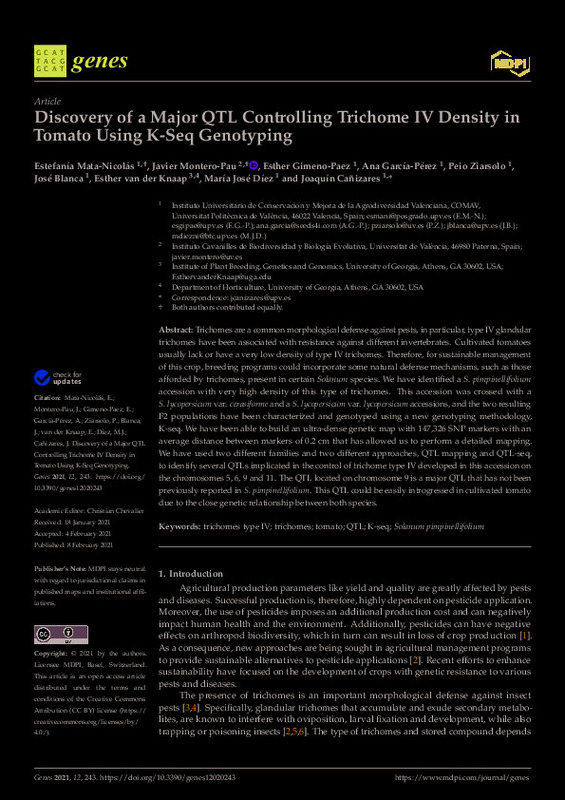JavaScript is disabled for your browser. Some features of this site may not work without it.
Buscar en RiuNet
Listar
Mi cuenta
Estadísticas
Ayuda RiuNet
Admin. UPV
Discovery of a Major QTL Controlling Trichome IV Density in Tomato Using K-Seq Genotyping
Mostrar el registro sencillo del ítem
Ficheros en el ítem
| dc.contributor.author | Mata-Nicolás, Estefanía
|
es_ES |
| dc.contributor.author | Montero-Pau, Javier
|
es_ES |
| dc.contributor.author | Gimeno -Páez, Esther
|
es_ES |
| dc.contributor.author | García-Pérez, Ana
|
es_ES |
| dc.contributor.author | Ziarsolo, Peio
|
es_ES |
| dc.contributor.author | Blanca Postigo, José Miguel
|
es_ES |
| dc.contributor.author | van der Knaap, Esther
|
es_ES |
| dc.contributor.author | Díez, María José
|
es_ES |
| dc.contributor.author | Cañizares Sales, Joaquín
|
es_ES |
| dc.date.accessioned | 2022-07-19T18:05:57Z | |
| dc.date.available | 2022-07-19T18:05:57Z | |
| dc.date.issued | 2021-02 | es_ES |
| dc.identifier.uri | http://hdl.handle.net/10251/184447 | |
| dc.description.abstract | [EN] Trichomes are a common morphological defense against pests, in particular, type IV glandular trichomes have been associated with resistance against different invertebrates. Cultivated tomatoes usually lack or have a very low density of type IV trichomes. Therefore, for sustainable management of this crop, breeding programs could incorporate some natural defense mechanisms, such as those afforded by trichomes, present in certain Solanum species. We have identified a S. pimpinellifolium accession with very high density of this type of trichomes. This accession was crossed with a S. lycopersicum var. cerasiforme and a S. lycopersicum var. lycopersicum accessions, and the two resulting F2 populations have been characterized and genotyped using a new genotyping methodology, K-seq. We have been able to build an ultra-dense genetic map with 147,326 SNP markers with an average distance between markers of 0.2 cm that has allowed us to perform a detailed mapping. We have used two different families and two different approaches, QTL mapping and QTL-seq, to identify several QTLs implicated in the control of trichome type IV developed in this accession on the chromosomes 5, 6, 9 and 11. The QTL located on chromosome 9 is a major QTL that has not been previously reported in S. pimpinellifolium. This QTL could be easily introgressed in cultivated tomato due to the close genetic relationship between both species. | es_ES |
| dc.description.sponsorship | This research was supported by the National Natural Science Foundation of USA Varitome project (NSF IOS 1564366). | es_ES |
| dc.language | Inglés | es_ES |
| dc.publisher | MDPI | es_ES |
| dc.relation.ispartof | Genes | es_ES |
| dc.rights | Reconocimiento (by) | es_ES |
| dc.subject | Trichomes type IV | es_ES |
| dc.subject | Trichomes | es_ES |
| dc.subject | Tomato | es_ES |
| dc.subject | QTL | es_ES |
| dc.subject | K-seq | es_ES |
| dc.subject | Solanum pimpinellifolium | es_ES |
| dc.subject.classification | GENETICA | es_ES |
| dc.title | Discovery of a Major QTL Controlling Trichome IV Density in Tomato Using K-Seq Genotyping | es_ES |
| dc.type | Artículo | es_ES |
| dc.identifier.doi | 10.3390/genes12020243 | es_ES |
| dc.relation.projectID | info:eu-repo/grantAgreement/NSF//NSF IOS 1564366/ | es_ES |
| dc.rights.accessRights | Abierto | es_ES |
| dc.contributor.affiliation | Universitat Politècnica de València. Departamento de Biotecnología - Departament de Biotecnologia | es_ES |
| dc.contributor.affiliation | Universitat Politècnica de València. Instituto Universitario de Conservación y Mejora de la Agrodiversidad Valenciana - Institut Universitari de Conservació i Millora de l'Agrodiversitat Valenciana | es_ES |
| dc.description.bibliographicCitation | Mata-Nicolás, E.; Montero-Pau, J.; Gimeno -Páez, E.; García-Pérez, A.; Ziarsolo, P.; Blanca Postigo, JM.; Van Der Knaap, E.... (2021). Discovery of a Major QTL Controlling Trichome IV Density in Tomato Using K-Seq Genotyping. Genes. 12(2):1-18. https://doi.org/10.3390/genes12020243 | es_ES |
| dc.description.accrualMethod | S | es_ES |
| dc.relation.publisherversion | https://doi.org/10.3390/genes12020243 | es_ES |
| dc.description.upvformatpinicio | 1 | es_ES |
| dc.description.upvformatpfin | 18 | es_ES |
| dc.type.version | info:eu-repo/semantics/publishedVersion | es_ES |
| dc.description.volume | 12 | es_ES |
| dc.description.issue | 2 | es_ES |
| dc.identifier.eissn | 2073-4425 | es_ES |
| dc.identifier.pmid | 33567670 | es_ES |
| dc.identifier.pmcid | PMC7915031 | es_ES |
| dc.relation.pasarela | S\427980 | es_ES |
| dc.contributor.funder | National Science Foundation, EEUU | es_ES |
| upv.costeAPC | 2017,04 | es_ES |








